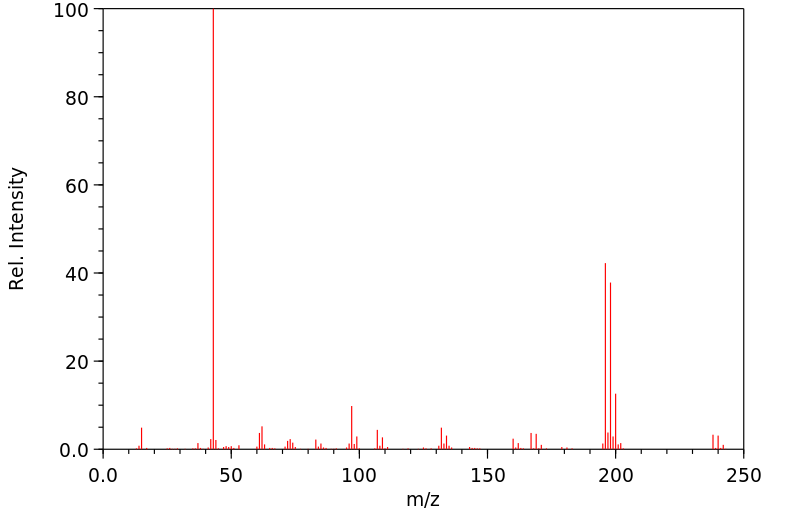三氯苯酚乙酸酯 | 23399-90-8
中文名称
三氯苯酚乙酸酯
中文别名
2,4,6-三氯苯酚乙酸酯
英文名称
2,4,6-trichlorophenyl acetate
英文别名
2,4,6-TCP acetate;acetic acid-(2,4,6-trichloro-phenyl ester);Essigsaeure-(2,4,6-trichlor-phenylester);2.4.6-Trichlor-1-acetoxy-benzol;(2.4.6-Trichlor-phenyl)-acetat;<2,4,6-Trichlor-phenyl>-acetat;(2,4,6-trichlorophenyl) acetate
CAS
23399-90-8
化学式
C8H5Cl3O2
mdl
MFCD01632750
分子量
239.485
InChiKey
RFOCPJZGJNKBOI-UHFFFAOYSA-N
BEILSTEIN
——
EINECS
——
-
物化性质
-
计算性质
-
ADMET
-
安全信息
-
SDS
-
制备方法与用途
-
上下游信息
-
文献信息
-
表征谱图
-
同类化合物
-
相关功能分类
-
相关结构分类
物化性质
-
熔点:49-51 °C
-
沸点:341.55°C (rough estimate)
-
密度:1.5422 (rough estimate)
-
保留指数:1424;1420;1420;1454;1423.2;1422.8
计算性质
-
辛醇/水分配系数(LogP):3.8
-
重原子数:13
-
可旋转键数:2
-
环数:1.0
-
sp3杂化的碳原子比例:0.125
-
拓扑面积:26.3
-
氢给体数:0
-
氢受体数:2
安全信息
-
海关编码:2915390090
SDS
反应信息
-
作为反应物:参考文献:名称:铜催化 sp3C-H 与酰基保护酚的醚化摘要:多种酰基保护的酚 AcOAr 参与底物 RH 的 sp3 CH 醚化,以 tBuOOtBu 作为氧化剂与铜 (I) β-二酮亚胺催化剂 [CuI] 一起得到烷基芳基醚 R-OAr。尽管 1°、2° 和 3° CH 键可以被官能化,但选择性研究表明优先构建受阻的 3° C-OAr 键。机理研究表明,β-二酮亚氨基铜 (II) 酚盐 [CuII]-OAr 在此 CO 键形成反应中起关键作用,通过 AcOAr 与 [CuI]-OtBu 中间体的酯交换反应形成 [CuI] 与 tBuOOtBu 反应。DOI:10.1021/jacs.6b09057
-
作为产物:参考文献:名称:ZANKE, D.;EDLICH, W., TAGUNSBER. AKAD. LANDWIRTSCHAFTSWISS. DDR,(1987) N 253, 283-288摘要:DOI:
文献信息
-
Highly efficient dynamic kinetic resolution of secondary aromatic alcohols with low-cost and easily available acid resins as racemization catalysts作者:Yongmei Cheng、Gang Xu、Jianping Wu、Chensheng Zhang、Lirong YangDOI:10.1016/j.tetlet.2010.02.152日期:2010.4A new and efficient dynamic kinetic resolution (DKR) process of secondary aromatic alcohols was developed with acid resins as racemization catalysts. Acid resin CD8604 was shown to have excellent racemization activity and good biocompatibility. When employing CD8604 and complex acyl donors as racemization catalyst and acyl donor, respectively, enantiomerically pure aromatic acetate was obtained with
-
4-(<i>N,N</i>-Dimethylamino)pyridine Hydrochloride as a Recyclable Catalyst for Acylation of Inert Alcohols: Substrate Scope and Reaction Mechanism作者:Zhihui Liu、Qiaoqiao Ma、Yuxiu Liu、Qingmin WangDOI:10.1021/ol4030875日期:2014.1.34-(N,N-Dimethylamino)pyridine hydrochloride (DMAP·HCl), a DMAP salt with the simplest structure, was used as a recyclable catalyst for the acylation of inert alcohols and phenols under base-free conditions. The reaction mechanism was investigated in detail for the first time; DMAP·HCl and the acylating reagent directly formed N-acyl-4-(N′,N′-dimethylamino)pyridine chloride, which was attacked by the
-
Tropolonate Salts as Acyl-Transfer Catalysts under Thermal and Photochemical Conditions: Reaction Scope and Mechanistic Insights作者:Demelza J. M. Lyons、Claire Empel、Domenic P. Pace、An H. Dinh、Binh Khanh Mai、Rene M. Koenigs、Thanh Vinh NguyenDOI:10.1021/acscatal.0c03702日期:2020.11.6strong nucleophilicity and photochemical activity, can promote the coupling reaction between alcohols and carboxylic acid anhydrides or chlorides to give products under thermal or blue light photochemical conditions. Kinetic studies and density functional theory calculations suggest interesting mechanistic insights for reactions promoted by this acyl-transfer catalytic system.
-
Basic compound, resist composition and patterning process申请人:——公开号:US20040234884A1公开(公告)日:2004-11-25Resist compositions comprising basic compounds having an imidazole skeleton and a polar functional group have an excellent resolution and an excellent focus margin and are useful in microfabrication using electron beams or deep-UV light.包含咪唑骨架和极性官能团的碱性化合物的抗蚀组合物具有优异的分辨率和优异的聚焦余量,并且适用于使用电子束或深紫外光进行微型加工。
-
8-ARM POLYETHYLENE GLYCOL DERIVATIVE, MANUFACTURING METHOD AND MODIFIED BIO-RELATED SUBSTANCE THEREBY申请人:Xiamen Sinopeg Biotech Co., Ltd.公开号:EP3315531A1公开(公告)日:2018-05-02Disclosed are an 8-arm polyethylene glycol (PEG) derivative (formula 1), manufacturing method and modified bio-related substance thereby, wherein a tetravalent group U and four trivalent groups Ec form a highly symmetric octavalent central structure CORE0 together, Lc connects the octavalent center to eight PEG arms having polydiversity or monodiversity and having n1-n8 as the degrees of polymerization thereof. The terminal of one PEG chain is connected to at least one functional group F (k ≥ 1), and said PEG chain and F can be directly connected (g = 0) or connected with a divalent linking group L0 connected with a terminal branched group G (g = 1) therebetween. The latter provides more reacting sites to combine more pharmaceutical molecules, thereby increasing the drug loading capacity. The near-center symmetric structure of the derivative allows more precise control over the molecular weight during large-scale production, thereby facilitating acquisition of a product having a narrower molecular weight distribution. A bio-related substance modified thereby has a more uniform and controllable performance.本发明公开了一种 8 臂聚乙二醇(PEG)衍生物(式 1)、其制造方法和改性生物相关物质,其中一个四价基团 U 和四个三价基团 Ec 共同形成一个高度对称的八价中心结构 CORE0,Lc 将八价中心连接到八个 PEG 臂上,这些 PEG 臂具有多元性或单元性,其聚合度为 n1-n8。一条 PEG 链的末端与至少一个官能团 F(k ≥ 1)相连,所述 PEG 链和 F 可以直接相连(g = 0),也可以通过二价连接基 L0 与中间的末端支化基 G(g = 1)相连。后者提供了更多的反应位点,可以结合更多的药物分子,从而提高药物负载能力。衍生物的近中心对称结构可以在大规模生产过程中更精确地控制分子量,从而有利于获得分子量分布更窄的产品。由此改性的生物相关物质具有更均匀、更可控的性能。
表征谱图
-
氢谱1HNMR
-
质谱MS
-
碳谱13CNMR
-
红外IR
-
拉曼Raman
-
峰位数据
-
峰位匹配
-
表征信息
同类化合物
马来酰亚胺四聚乙二醇CH2CH2COOPFPESTER
马来酰亚胺六聚乙二醇CH2CH2COOPFPESTER
马来酰亚胺-酰胺-PEG8-四氟苯酚酯
马来酰亚胺-四聚乙二醇-五氟苯酯
马来酰亚胺-三聚乙二醇-五氟苯酚酯
靛酚乙酸酯
阿立哌唑标准品002
间硝基苯基戊酸酯
间氯苯乙酸乙酯
间乙酰苯甲酸
钾4-乙酰氧基苯磺酸酯
酚醛乙酸酯
邻苯二酚二乙酸酯
邻甲苯基环己甲酸酯
邻甲氧基苯乙酸酯
辛酸苯酯
辛酸对甲苯酚酯
辛酸五氯苯基酯
辛酸-(3-氯-苯基酯)
辛酰溴苯腈
苯酰胺,3,4-二(乙酰氧基)-N-[6-氨基-1,2,3,4-四氢-1-(4-甲氧苯基)-3-甲基-2,4-二羰基-5-嘧啶基]-
苯酚-乳酸
苯酚,4-异氰基-,乙酸酯(ester)
苯酚,4-[(四氢-2H-吡喃-2-基)氧代]-,乙酸酯
苯酚,3-(1,1-二甲基乙基)-,乙酸酯
苯酚,2-溴-3-(二溴甲基)-5-甲氧基-,乙酸酯
苯甲醇,4-(乙酰氧基)-3,5-二甲氧基-
苯甲酸,4-(乙酰氧基)-2-氟-
苯氧基氯乙酸苯酯
苯基金刚烷-1-羧酸酯
苯基氰基甲酸酯
苯基庚酸酯
苯基庚-6-炔酸酯
苯基己酸酯
苯基呋喃-2-羧酸酯
苯基吡啶-2-羧酸酯
苯基十一碳-10-烯酸酯
苯基乙醛酸酯
苯基乙酸酯-d5
苯基丙二酸单苯酯
苯基丙-2-炔酸酯
苯基丁-2,3-二烯酸酯
苯基4-乙基环己烷羧酸
苯基3-乙氧基-3-亚氨基丙酸盐
苯基2-(苯磺酰基)乙酸酯
苯基2-(4-甲氧基苯基)乙酸酯
苯基2-(2-甲氧基苯基)乙酸酯
苯基2-(2-甲基苯基)乙酸酯
苯基-乙酸-(2-甲酰基-苯基酯)
苯基-乙酸-(2-环己基-苯基酯)







